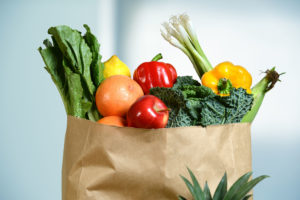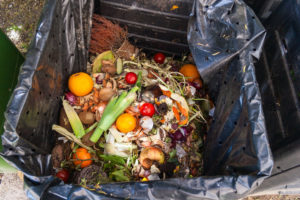Tips for Simple Living to Avoid Food Waste
 The federal government has established a goal to reduce food waste 50 percent by 2030. Here are a few simple steps that can help families prevent waste at home:
The federal government has established a goal to reduce food waste 50 percent by 2030. Here are a few simple steps that can help families prevent waste at home:
(1) Keep a food inventory of what you have on hand in your freezer, refrigerator, and cupboards/pantries. Knowing what you need to purchase helps cut down on waste as you plan your menu.
(2) Spend some time using a portion calculator as you start to make your meals. Often waste happens when we cook too much of items that do not keep well. An online helper can be found at: www.lovefoodhatewaste.com/portion-planner
(3) Shop in your refrigerator first! Cook or eat what you have at home before buying more food.
(4) Be creative with leftovers. Often they can become a great meal or lunch the next day by simply putting leftovers in a good thermos. Small dabs can be put to use in soups, stocks, or frozen for future recipes.
(5) Plan! Your best friend for saving money on your food bill and cutting waste is a weekly meal plan.
(6) If you do have unusable food scraps, help divert them from the landfills by composting.
Facts and Figures on Food Waste
How does America throw away sixty-three million tons of food each year while forty million Americans are considered food insecure?
 Frank Yiannas, a deputy commissioner at the FDA, says, “Imagine going to the grocery store and buying three bags of groceries, and as you leave you throw one of those bags in the garbage can.” The vast majority of waste, 80 percent, is generated by homes, grocery stores, and restaurants. Our own homes account for 43 percent of all food waste, which equals roughly four hundred pounds of food loss per year for each American!
Frank Yiannas, a deputy commissioner at the FDA, says, “Imagine going to the grocery store and buying three bags of groceries, and as you leave you throw one of those bags in the garbage can.” The vast majority of waste, 80 percent, is generated by homes, grocery stores, and restaurants. Our own homes account for 43 percent of all food waste, which equals roughly four hundred pounds of food loss per year for each American!
Building a better way for stores and restaurants to cycle their unused items to food banks varies from city to city and region to region. It is estimated that 1.7 billion meals per year could be provided if this type of waste is stopped. Translated into economics this equals $161 billion dollars worth of food loss.
Some food waste cannot be salvaged, but only 5 percent of this food is sent to composts while European nations send fifteen percent. Food waste is the single largest component going into municipal landfills, which generates the third largest source of methane, a powerful greenhouse gas in the U.S. It costs $750 million a year just to dispose of the food we carelessly throw away.
Biblical Stewardship of Creation and Food
Jesus gave us a wonderful lesson on food economy when He fed the five thousand. This is so important that all four of the Gospels record this touching story—Matthew 14:13–21, Mark 6:31–22; Luke 9:12–17; and John 6:1–14. Jesus said to His disciples, “Gather up the fragments that remain, that nothing be lost” (NASE).
He could have easily just let things go and not given this instruction, but He wanted to teach us that when we are in a trying circumstance, we can choose to practice good stewardship of God’s creation. Jesus’ message was to discard nothing that could be utilized. God has blessed humans with the ability to have forethought, wisdom, and ingenuity. Reading stories of families going through the depression or surviving hard times in mission work can also help us learn valuable lessons about food use.
The feeding of the five thousand starts with a very important emotion that can inspire us to be more careful about food. Matthew 14:14 says, “And Jesus went forth, and saw a great multitude, and was moved with compassion toward them” (KJV). We, too, can be moved with compassion for those who do not have much and make good choices on how to use food wisely.



